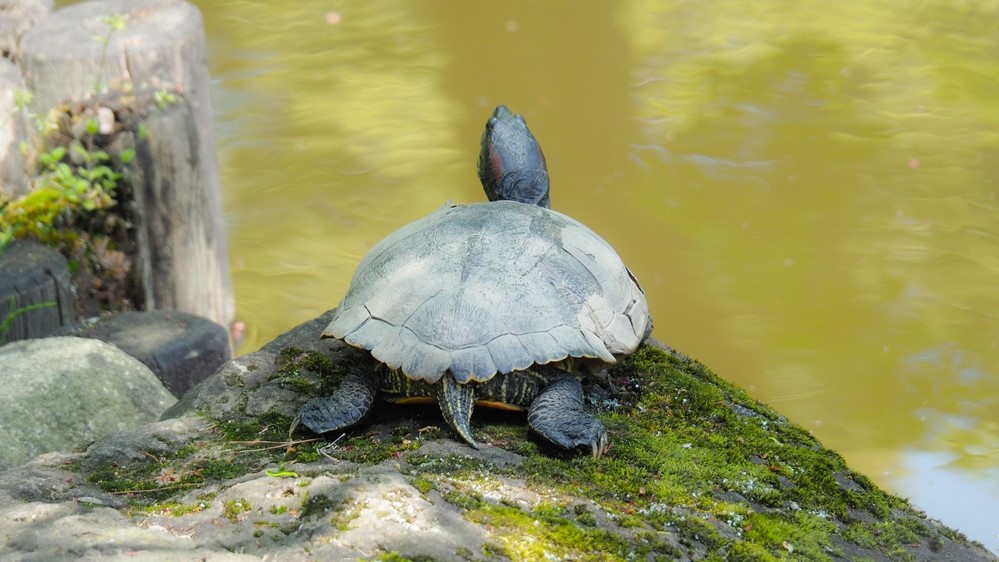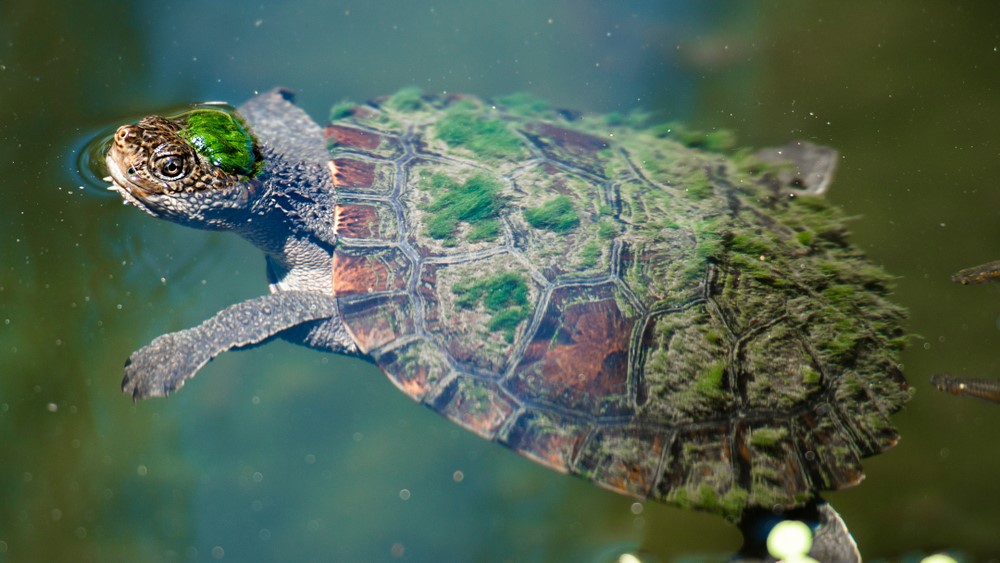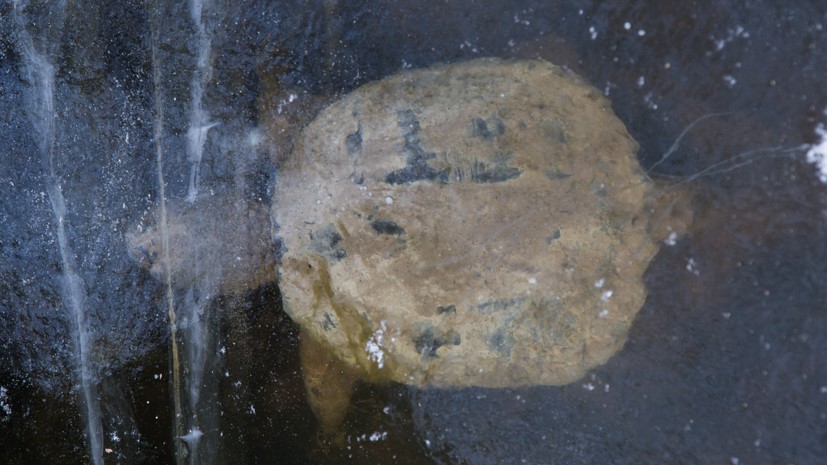Can turtles really breathe through their butts?
It depends how you define "breathe" and "butts."
Everyone knows that most mammals breathe through the mouth and nose. Frogs, meanwhile, can breathe through their skin. But what about turtles? How do these hard-shelled critters get oxygen?
You may have heard a strange rumor that turtles can breathe through their butts. But is this true?
Technically, turtles do not breathe through their derrières. That's because turtles don't really have "butts"; instead, they have a multipurpose opening known as a cloaca, which is used for sexual reproduction and egg laying as well as for expelling waste. However, they do engage in a process called cloacal respiration, which could, in a less technical sense, be interpreted as "butt breathing."
During cloacal respiration, turtles pump water through their cloacal openings and into two sac-like organs known as bursae, which act sort of like aquatic lungs, Craig Franklin, a wildlife physiologist at The University of Queensland in Australia who has extensively studied cloacal respiration, told Live Science. Oxygen in the water then diffuses across the papillae, small structures that line the walls of the bursae, and into the turtle's bloodstream.
Related: Why do turtles live so long?
However, cloacal respiration is very inefficient compared with normal aerobic respiration ,and all turtles also have the capacity to breathe air with their lungs much more easily. As a result, cloacal respiration is seen only in a small number of freshwater species that rely on this unorthodox method to overcome challenges they face in unique environments where it is hard to breathe air, such as fast-flowing rivers or frozen ponds.
Cloacal champions
The main turtle group that has truly mastered cloacal respiration is river turtles. Globally, there are around a dozen river turtles that can properly utilize cloacal respiration, around half of which live in rivers in Australia; these include the Mary River turtle (Elusor macrurus) and the white-throated snapping turtle (Elseya albagula), Franklin said.
Get the world’s most fascinating discoveries delivered straight to your inbox.
However, some species of river turtle are much better at cloacal respiration than others. The undisputed champion is the Fitzroy River turtle (Rheodytes leukops) from Australia, which can derive 100% of its energy through cloacal respiration. "This allows them to potentially remain underwater indefinitely," Franklin said.
But for all other species, cloacal respiration only extends the amount of time they can stay underwater until they must resurface for air. "For example, instead of diving underwater for 15 minutes [while holding their breath], they can remain underwater for several hours," he said.
The ability to stay underwater for extended periods of time is extremely useful for river turtles because going to the surface can be hard work. "For a turtle that lives in fast-flowing water, going to the surface to breathe represents a bit of an issue because you could get swept away," Franklin said. Staying close to the riverbed also makes it easier to avoid predators such as crocodiles, he added.
Avoiding predators is particularly important for baby turtles, which can be targeted by birds and large fish. "The greatest risk of predation for a hatching turtle is swimming through the water column to the surface," Franklin said. As a result, juveniles are normally much better at cloacal respiration than adults, which allows them to spend more time near the riverbed until they are big enough to start venturing more frequently to the surface. Therefore, it is possible that additional river turtle species are also capable of cloacal respiration as juveniles but then lose this ability in later life, Franklin said.
However, cloacal respiration is much less efficient than aerobic respiration because pumping water into the bursae requires a lot of energy, which reduces the net gain of energy the turtles receive. "When we breathe air, there's virtually no energy required" because gases are light and flow freely in and out of our lungs, Franklin said. "But imagine trying to breathe a viscous liquid back and forth." Water also has around 200 times less oxygen than an equal volume of air, so turtles have to pump more of it to gain the same amount of oxygen, he added.
Related: How do animals breathe underwater?
There is also another cost to cloacal respiration. When oxygen diffuses across the skin of the bursae and into the bloodstream, sodium and chloride ions (charged particles) inside papillae, which are vital to the functioning of cells, diffuse in the opposite direction into the water, which stops the cells from functioning properly. To counteract this, the turtles have evolved special pumps that suck the lost ions back into the cells to maintain normal ion levels. This process, known as osmoregulation, requires additional energy, thus further reducing the net gain of energy from cloacal respiration.
Stuck under ice
There are also around six or seven species of hibernating freshwater turtles across North America that are capable of a more limited form of cloacal respiration. These species, such as Blanding's turtle (Emydoidea blandingii), spend months trapped beneath layers of ice that cover ponds during the winter. Some of these turtles are under the ice for more than 100 days without being able to take a single breath of air, Jackie Litzgus, a wildlife ecologist at Laurentian University in Ontario, told Live Science. Instead, these turtles can also take up oxygen through bursae, as well as by gargling water in their throats, which is known as buccal pumping, Litzgus said.
However, the cloacal respiration displayed by hibernating turtles is much less complex than what the river turtles are capable of, Franklin said. Instead of actively pumping water into their bursae like their river-dwelling relatives do, the hibernating turtles take up oxygen that passively diffuses across the skin in the bursae. This process is more like cutaneous respiration — when oxygen diffuses through an animal's skin, which happens in amphibians, reptiles and, in a limited capacity, some mammals, including humans.
The hibernating turtles get away with this passive form of cloacal respiration because they have a greatly reduced metabolic rate, which means they need less energy and, therefore, less oxygen. While they are under the ice, these turtles do not move around very much, keep their body temperature close to freezing and can switch to anaerobic respiration — a last resort for creating energy without oxygen — when they are low on oxygen, Litzgus said.
Originally published on Live Science.

Harry is a U.K.-based senior staff writer at Live Science. He studied marine biology at the University of Exeter before training to become a journalist. He covers a wide range of topics including space exploration, planetary science, space weather, climate change, animal behavior and paleontology. His recent work on the solar maximum won "best space submission" at the 2024 Aerospace Media Awards and was shortlisted in the "top scoop" category at the NCTJ Awards for Excellence in 2023. He also writes Live Science's weekly Earth from space series.






